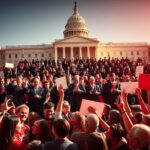The Middle East has been a key area of international talks for years. The Israeli-Palestinian conflict is at the heart of these discussions. Recently, the Trump administration proposed establishing a “freedom zone“ in Gaza. which has sparked significant debate.
This idea aims to boost the area’s economy and stability. Supporters believe it could be a big step toward peace. But critics think it’s not a real solution and doesn’t tackle the conflict’s main problems.
This proposal could change the face of Middle East diplomacy in 2025. The world is watching to see if it will succeed or fail. Its outcome could have big effects.
Key Takeaways
- The Trump administration’s ‘Freedom Zone’ proposal aims to promote economic growth in Gaza.
- Critics argue that the plan may not address the root causes of the Israeli-Palestinian conflict.
- The proposal’s success could significantly impact Middle East diplomacy efforts in 2025.
- The plan’s viability depends on various factors, including international support and regional stability.
- The ‘Freedom Zone’ initiative is considered a potentially game-changing idea by its supporters.
The Unveiling of Trump’s Gaza ‘Freedom Zone’ Proposal
Trump’s ‘Freedom Zone’ plan for Gaza is a new approach to US foreign policy. It aims to solve Gaza’s economic and humanitarian problems. The plan includes economic growth and security measures.
Key Components of the Freedom Zone Plan
The Freedom Zone plan consists of several key components. They aim to enhance the economy and maintain peace. These include:
- Establishing special zones for foreign investment is an example of economic development.
- The security plans involve collaborating with other nations to enhance safety.
- We are implementing governance reforms to enhance the ease and transparency of conducting business.
These parts are meant to work together. They aim to help Gaza’s economy grow and meet the people’s needs.
Timeline for Implementation in the Second Trump Administration
The plan’s timeline is ambitious, with big goals for Trump’s second term. The milestones are:
- Start planning and talking to stakeholders in the first 100 days.
- Begin economic projects in the first year.
- Put in place security and governance reforms later on.
This timeline shows the administration’s eagerness to tackle Gaza’s issues.
Historical Context: Gaza’s Economic and Humanitarian Crisis
To understand Gaza’s crisis, we must look at its history and the Israel-Hamas war’s effects. The Gaza Strip has long faced economic and humanitarian issues. This has made it a key concern for the world.
Pre-2025 Conditions Following the Israel-Hamas War
The Israel-Hamas war has made Gaza’s situation worse. By pre-2025, Gaza was in a dire state. Gaza experienced high rates of poverty and unemployment, and its infrastructure suffered significant damage.
Economic activities were severely limited. Restrictions on movement and access to basic needs exacerbated the crisis. The world has tried to help, but finding lasting solutions has been challenging.
Previous Failed Reconstruction Initiatives
Gaza has tried to rebuild after conflicts before, but these efforts have failed. There are many problems, including political instability and security issues. Furthermore, getting aid to Gaza is complex.
“The reconstruction of Gaza is not just about rebuilding infrastructure; it’s about building a sustainable future for its people.”
These failures show we need a new way to help Gaza. Ideas like Trump’s ‘Freedom Zone’ could tackle Gaza’s deep-seated problems.
The Trump Gaza Freedom Zone: Concept and Vision
Trump’s Gaza ‘Freedom Zone’ plan is a complex idea. It aims to tackle the economic and security issues in Gaza. The goal is to make the region more stable and prosperous through economic growth and better security.
This plan has caught a lot of attention. Many are wondering if it will help the Middle East peace process. At its core, the ‘Freedom Zone’ aims to boost Gaza’s economy and attract more investment.
Economic Development Framework
The Trump Gaza ‘Freedom Zone’ plan focuses on economic growth. It wants to encourage private investment, improve infrastructure, and increase trade. The plan also aims to grow Gaza’s manufacturing sector and expand its market reach.
By making Gaza more attractive for businesses, the plan hopes to create jobs. Such an effort could help reduce poverty and improve life for people in Gaza.
Security and Governance Arrangements
The plan also includes security and governance measures. These are key to making Gaza stable and secure. This stability is important for attracting investors and promoting economic growth.
The plan suggests working together with Israel, the Palestinian Authority, and other groups. They aim to stop weapon smuggling and improve border security. This cooperation is vital for Gaza’s security and stability.
By tackling both economic and security issues, the Trump ‘Freedom Zone’ aims to make Gaza a more stable and prosperous place. The move is a big step toward lasting peace in the Middle East.
Diplomatic Implications for US-Middle East Relations
Trump’s Gaza initiative could change US foreign policy in the Middle East. It will affect Israel and Palestine. The plan has elicited various reactions, which illustrate the complexity of the diplomatic situation.

Reshaping US-Israel Relations Under Trump’s Return
The ‘Freedom Zone’ plan will likely change US-Israeli relations. Trump’s return might strengthen ties with Israel. This could happen through security and economic cooperation.
But there might be tensions. Israel could see the plan as a threat to its sovereignty. Or, it might not meet Israeli security needs.
Engagement Strategy with Palestinian Leadership
Working with Palestinian leaders is key to the “Freedom Zone”‘s success. A diplomatic breakthrough could happen if Palestinians see it as a step toward statehood. But there’s a lot of skepticism.
The strategy must tackle big issues like the right of return and territorial integrity. It also needs to win Palestinian trust.
Trump’s Gaza ‘Freedom Zone’ plan has many diplomatic challenges. It needs a careful approach to US-Israel relations and Palestinian engagement. Success depends on smart diplomacy and balancing regional interests.
Regional and International Reactions
Trump’s ‘Freedom Zone’ plan for Gaza has sparked a lot of diplomatic talk. Many countries are watching this move closely. It’s part of a bigger Middle East diplomacy plan in 2025.
Palestinian Authority and Hamas Responses
The Palestinian Authority feels optimistic about the ‘Freedom Zone.’ They see it as a chance to talk more about Palestinian statehood. But they worry it might be just empty words without action.
Hamas is more doubtful. They question if the plan can really work. They also worry it might ignore the need for Palestinian unity.
Arab States’ Perspectives
Arab countries have mixed feelings about the ‘Freedom Zone.’ Some, like Jordan and Egypt, are interested in its economic benefits. But others are skeptical. They think it might make things more complicated in the region.
European and Global Diplomatic Reception
The European Union and other global players are watching closely. All parties must agree on any solution and ensure it adheres to international law. Some see the economic benefits, but others are worried about its impact on the Israeli-Palestinian conflict.
The different reactions show how complex the Gaza ‘Freedom Zone’s plan is. It points out that it takes a coordinated international response to solve the region’s profound problems.
Economic Feasibility and Development Plans
Understanding the economic feasibility of Trump’s Gaza initiative is key to its success. The plan for a Gaza ‘Freedom Zone’ includes funding, infrastructure, and identifying industries. These are vital for economic growth.

Proposed Funding Mechanisms and US Foreign Aid Commitments
The Gaza ‘Freedom Zone’ will be funded by US foreign aid, international donations, and private investments. The Trump administration plans to use existing foreign aid for Gaza projects. However, the acquisition of additional funding from other sources remains uncertain.
US foreign aid is vital for Gaza’s reconstruction. It will help with infrastructure and creating jobs.
Infrastructure Development Priorities
Infrastructure is central to the Gaza ‘Freedom Zone’ plan. It includes fixing damaged buildings, improving roads, and boosting energy and water systems. The goal is to support economic growth by bettering the infrastructure.
Projects might include rebuilding roads, bridges, and public transport. Investing in renewable energy can also address Gaza’s energy crisis.
Potential Industries and Economic Opportunities
The “Freedom Zone” in Gaza aims to create jobs in manufacturing, technology, and agriculture. Special economic zones could draw foreign investment, boosting the economy.
This area could become a key economic center. It could help stabilize and grow the region’s economy.
Humanitarian Considerations and Human Rights Framework
Gaza’s long humanitarian crisis has made the ‘Freedom Zone’ idea important. Trump’s team suggested it as a way to bring stability. Gaza faces big problems like a bad economy, limited movement, and a need for aid.
Addressing the Ongoing Gaza Humanitarian Crisis
The ‘Freedom Zone’ plan wants to help Gaza by easing travel rules and boosting jobs. It includes building new infrastructure and helping with aid. Such an effort could help reduce the suffering of Gazans.
Freedom of Movement and Civil Rights Provisions
A big part of the ‘Freedom Zone’ is making it easier for Gazans to move around. Such an effort is key to solving the crisis. The plan also aims to improve civil rights, which are vital for a fair society. Getting this right is key to the plan’s success.
The ‘Freedom Zone’ plan’s success in Gaza depends on how well it’s done and who helps. It’s important to make sure the plan focuses on what Gazans need and their rights.
Political Motivations and Strategic Calculations
Trump’s plan for a “Freedom Zone” in Gaza is complex. It’s shaped by many factors, including domestic politics and a desire to leave a mark. It also involves strategic moves in the Middle East.
Domestic Political Considerations in the US
Domestic politics are the driving force behind Trump’s Gaza plan. He wants to win over his base and certain voters. It shows his support for Israel and his bold diplomacy.
The plan ties into Trump’s immigration policies and Supreme Court actions. It aims to show his team’s skill in handling big global issues.
Legacy-Building and Trump’s Middle East Strategy
Trump wants a lasting legacy in the Middle East. His “Freedom Zone” in Gaza is part of this effort. It’s designed to make the region more stable and prosperous.
- Promoting economic development through innovative financing mechanisms
- Enhancing regional security through strategic alliances
- Fostering greater diplomatic engagement between Israel and its neighbors
Connection to Trump’s Supreme Court Immigration Policies
The “Freedom Zone” in Gaza shares themes with Trump’s immigration policies. It focuses on security, controlled borders, and the rule of law. Both reflect Trump’s governance style and international relations.
Looking at these connections helps us understand Trump’s Gaza plan. It shows the strategic calculations behind it and its impact on US foreign policy.
Implementation Challenges and Possible Obstacles
Trump’s plan for a “Freedom Zone” in Gaza faces many hurdles. It aims to revitalize Gaza, but it must overcome several obstacles. These challenges could affect its success.
Legal and Territorial Complications
The Gaza ‘Freedom Zone’ plan deals with legal and territorial issues. Gaza’s status and boundaries are disputed. The plan needs cooperation from Israel, the Palestinian Authority, and others.
- Disputes over territorial sovereignty
- Existing legal frameworks and agreements
- Coordination among various international and local entities
Dealing with these issues is key to the plan’s success.
Security Enforcement Mechanisms
Keeping the ‘Freedom Zone’ safe is a big challenge. Gaza has seen a lot of conflict. Strong security measures are needed.
Key considerations include:
- Collaboration with local security forces
- International support and involvement
- Technological and infrastructural investments
Good security is essential for economic growth.
Timeline Feasibility Assessment
The plan’s timeline is ambitious, with many goals to reach quickly. It’s important to check if this timeline is realistic.
“The success of the Gaza ‘Freedom Zone’ hinges on its ability to execute the plan within the proposed timeline, which is challenging given the complexity of the issues involved.”
It’s vital to assess the timeline and make changes if needed. These adjustments will help the plan succeed.
Expert Analysis and Scholarly Perspectives
Experts are diving into Trump’s Gaza ‘Freedom Zone’ plan. They see a mix of diplomatic and economic factors at play. The plan’s strengths and weaknesses are being closely examined.
Middle East Policy Experts’ Evaluations
Middle East policy experts have shared their thoughts on the Trump Gaza ‘Freedom Zone’ plan. Some think it’s a pragmatic way to solve the Gaza crisis. Others believe it could be divisive.
Dr. Anne-Marie Slaughter, a top expert in international relations, says the plan’s success depends on balancing Israeli security with Palestinian needs.
“The Freedom Zone could be a game-changer if implemented correctly, but it requires a delicate balance of diplomatic and economic efforts.”
Economic Development Specialists’ Assessments
Economic experts are looking at the plan’s economic ups and downs. They say the focus on economic growth is a big plus. But it needs excellent infrastructure planning and smart investment strategies.
Historical Precedents and Lessons
Looking at past efforts in the region can teach us a lot. Long-term commitment and cooperation are key to success. Dr. Steven Spiegel, a historian and Middle East expert, says understanding Gaza’s past is vital for finding a solution.
The Gaza ‘Freedom Zone’ plan could be a big change in Middle East policy. But it needs careful planning, international teamwork, and a deep grasp of the region’s complex politics.
Conclusion: Assessing the Freedom Zone’s Prospects in 2025 and Beyond
The Trump Gaza ‘Freedom Zone’ plan has sparked significant debate among various stakeholders. It aims to improve the Gaza Strip. Looking ahead to 2025 and beyond, we must think about many factors.
The plan’s success depends on solving Gaza’s economic and humanitarian problems. It wants to boost the economy, improve security, and better governance. But it needs the help of many groups, like the Palestinian Authority and Israel.
Looking at the Middle East peace deal, the plan’s future is unclear. Some see it as a chance for peace, while others doubt it. The outcome will depend on everyone working together to overcome obstacles and find ways forward.
How Could U.S. Mediation Influence the Success of Trump’s Gaza ‘Freedom Zone’?
U. S. mediation could play a pivotal role in the success of Trump’s Gaza ‘Freedom Zone’ by establishing a framework for dialogue. This approach might serve as a precedent for addressing other regional disputes, such as the indiapakistan water conflict resolution options, fostering an environment where collaborative peace efforts can thrive.
FAQ
What is Trump’s Gaza ‘Freedom Zone’ proposal?
Trump’s Gaza ‘Freedom Zone’ plan aims to solve the Gaza crisis. It focuses on economic growth, security, and better governance. The proposal is part of his 2025 Middle East diplomacy efforts.
What are the key components of the Freedom Zone plan?
The plan includes economic growth, security, and governance. The plan aims to stabilize the region and ease Gaza’s humanitarian crisis.
How does the Trump Gaza Freedom Zone plan address the Gaza humanitarian crisis?
The plan tackles the crisis through economic growth, security, and governance. It aims for sustainable growth and focuses on humanitarian needs.
What is the proposed timeline for implementing the Freedom Zone plan?
The plan aims to be implemented during Trump’s second term. But its success depends on many geopolitical factors.
How does the Freedom Zone proposal impact US-Israel relations?
The proposal could change US-Israel relations. It’s part of Trump’s strategy for the Middle East.
What are the reactions of the Palestinian Authority and Hamas to the Freedom Zone proposal?
The Palestinian Authority and Hamas have different views on the proposal. Their reactions show their perspectives on Gaza’s crisis and regional stability.
What is the economic feasibility of the Freedom Zone proposal?
The plan’s success depends on funding, US aid, and infrastructure. These factors will help determine Gaza’s economic growth.
How does the Freedom Zone proposal address humanitarian considerations and human rights?
The plan aims to solve the humanitarian crisis and protect human rights. It includes efforts to improve Gaza’s situation.
What are the potential roadblocks to implementing the Freedom Zone proposal?
Legal issues, security, and the timeline could be obstacles. These factors might affect the plan’s success.
How does the Freedom Zone proposal relate to Trump’s Supreme Court immigration policies?
The proposal is linked to Trump’s immigration policies. It shows his administration’s approach to both domestic and foreign policy.
What do Middle East policy experts and economic development specialists say about the Freedom Zone proposal?
Experts have mixed opinions. They evaluate the plan based on their knowledge of Middle East policy and economic development.
What is the potential impact of the Freedom Zone proposal on regional stability?
The plan’s success is key to regional stability. The reactions of regional actors and the Middle East’s broader context also matter.
(Relevant Links):
Council on Foreign Relations: US-Gaza Policy History
Trump touts ‘freedom zone’ plan for Gaza as ceasefire talks stall in Qatar









































































































